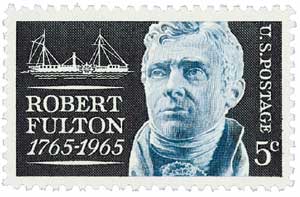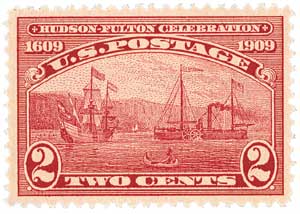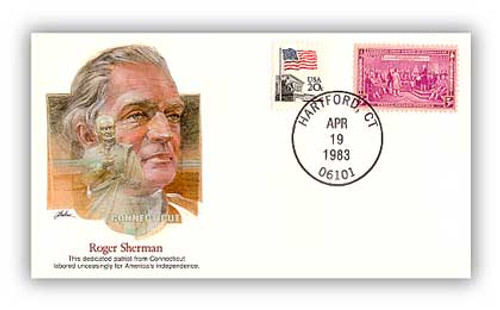
# 126691 - 1982 PRA Robert Fulton
This neat commemorative cover was canceled on Robert Fulton's 217th birthday near his birthplace in Pennsylvania. It features the 1965 Fulton bicentennial stamp. It'll make a fun and historic addition to your collection.
Birth Of Robert Fulton

Engineer and inventor Robert Fulton was born on November 14, 1765, in Little Britain, Lancaster County, Pennsylvania.
From a young age, Robert Fulton showed a great talent for art. After his father died, he moved to Philadelphia and painted portraits and landscapes and provided technical drawings for houses and machinery to provide for his mother and siblings. While in Philadelphia he met Benjamin Franklin and several businessmen who encouraged him to travel to Europe to further his art training.
Fulton arrived in England in 1786 and lived with Benjamin West, who had been friends with his father. While Fulton received several commissions for portraits and landscapes, he liked to experiment with inventions in his free time. This led Fulton to develop his idea for tub-boat canals that used inclined planes instead of locks. He also began researching the use of steam for boats and patented a dredging machine.

Fulton moved to Paris in 1797, where he learned French, German, mathematics, and chemistry. He then started designing torpedoes and submarines. In 1800, he tested the first practical submarine, the Nautilus, which went under water for 17 minutes. Working with U.S. Ambassador to France Robert Livingston, Fulton began designing steamboats, but put that work aside for a time to design the first modern naval torpedoes and other weapons for England during their war with France.

Fulton returned to America in 1806 and resumed work on a steamboat with Livingston. While others had invented steamboats before him, they were often considered dangerous and nothing more than a novelty. But Fulton believed it could prove to be a successful business venture, and built a 150-foot-long ship that would make him famous. Critics dubbed the boat “Fulton’s Folly,†believing it wouldn’t make the trip.

On the afternoon of August 17, 1807, Fulton and a group of passengers boarded his ship North River Steamboat (later named the Clermont) in New York City, bound for Albany, 150 miles up the Hudson River. Shortly after leaving the dock, the boat stopped suddenly. Passengers and spectators willingly shared their doubt in the boat’s abilities. Fulton calmly went below the deck, found the problem, and easily fixed it. The boat then chugged along at a leisurely five miles per hour without any other incidents. They arrived in Albany (after a stopover at Livingston’s home, Clermont) in a record 32 hours. While many had their doubts, Fulton proved the commercial viability of steam boats, which would rule American waterways for the next half-century.

After that success, Fulton was made part of the Erie Canal Commission. During this time he also worked on another boat, New Orleans, which he took on a long trip down the Ohio River. The journey was through relatively uncharted territory and the fact that he was able to get the boat down the river and back home was a major milestone.
In early 1815, Fulton was walking home on the frozen Hudson River when one of his friends fell through the ice. Fulton rescued his friend, but was soaked in the cold water and caught pneumonia. He then contracted consumption and died on February 24, 1815, in New York City.

A number of towns and other locations have been named for Fulton throughout the country. There have also been five U.S. Navy ships named for him and he was honored as part of the Hudson-Fulton Celebration in 1909.
This neat commemorative cover was canceled on Robert Fulton's 217th birthday near his birthplace in Pennsylvania. It features the 1965 Fulton bicentennial stamp. It'll make a fun and historic addition to your collection.
Birth Of Robert Fulton

Engineer and inventor Robert Fulton was born on November 14, 1765, in Little Britain, Lancaster County, Pennsylvania.
From a young age, Robert Fulton showed a great talent for art. After his father died, he moved to Philadelphia and painted portraits and landscapes and provided technical drawings for houses and machinery to provide for his mother and siblings. While in Philadelphia he met Benjamin Franklin and several businessmen who encouraged him to travel to Europe to further his art training.
Fulton arrived in England in 1786 and lived with Benjamin West, who had been friends with his father. While Fulton received several commissions for portraits and landscapes, he liked to experiment with inventions in his free time. This led Fulton to develop his idea for tub-boat canals that used inclined planes instead of locks. He also began researching the use of steam for boats and patented a dredging machine.

Fulton moved to Paris in 1797, where he learned French, German, mathematics, and chemistry. He then started designing torpedoes and submarines. In 1800, he tested the first practical submarine, the Nautilus, which went under water for 17 minutes. Working with U.S. Ambassador to France Robert Livingston, Fulton began designing steamboats, but put that work aside for a time to design the first modern naval torpedoes and other weapons for England during their war with France.

Fulton returned to America in 1806 and resumed work on a steamboat with Livingston. While others had invented steamboats before him, they were often considered dangerous and nothing more than a novelty. But Fulton believed it could prove to be a successful business venture, and built a 150-foot-long ship that would make him famous. Critics dubbed the boat “Fulton’s Folly,†believing it wouldn’t make the trip.

On the afternoon of August 17, 1807, Fulton and a group of passengers boarded his ship North River Steamboat (later named the Clermont) in New York City, bound for Albany, 150 miles up the Hudson River. Shortly after leaving the dock, the boat stopped suddenly. Passengers and spectators willingly shared their doubt in the boat’s abilities. Fulton calmly went below the deck, found the problem, and easily fixed it. The boat then chugged along at a leisurely five miles per hour without any other incidents. They arrived in Albany (after a stopover at Livingston’s home, Clermont) in a record 32 hours. While many had their doubts, Fulton proved the commercial viability of steam boats, which would rule American waterways for the next half-century.

After that success, Fulton was made part of the Erie Canal Commission. During this time he also worked on another boat, New Orleans, which he took on a long trip down the Ohio River. The journey was through relatively uncharted territory and the fact that he was able to get the boat down the river and back home was a major milestone.
In early 1815, Fulton was walking home on the frozen Hudson River when one of his friends fell through the ice. Fulton rescued his friend, but was soaked in the cold water and caught pneumonia. He then contracted consumption and died on February 24, 1815, in New York City.

A number of towns and other locations have been named for Fulton throughout the country. There have also been five U.S. Navy ships named for him and he was honored as part of the Hudson-Fulton Celebration in 1909.












